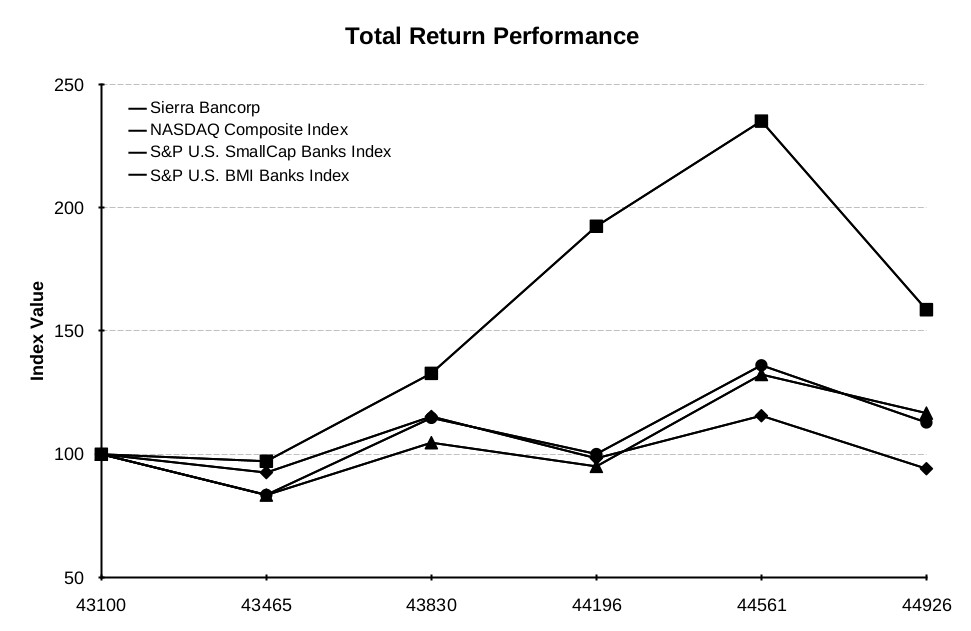The TRUPS II are subject to mandatory redemption to the extent of any early redemption of the related Subordinated Debentures and upon maturity of the Subordinated Debentures on March 17, 2034.
Trust II has the option to defer payment of the distributions for a period of up to five years, subject to certain conditions, including that the Company may not pay dividends on its common stock during such period. The TRUPS II issued in the offering were sold in private transactions pursuant to an exemption from registration under the Securities Act of 1933, as amended. The Company has guaranteed, on a subordinated basis, distributions and other payments due on the TRUPS II.
During the second quarter of 2006, Sierra Capital Trust III issued 15,000 Floating Rate Capital Trust Pass-Through Securities (TRUPS III), with a liquidation value of $1,000 per security, for gross proceeds of $15,000,000. The entire proceeds of the issuance were invested by Trust III in $15,464,000 of Subordinated Debentures issued by the Company, with identical maturity, repricing and payment terms as the TRUPS III. The Subordinated Debentures, purchased by Trust III, represent the sole assets of the Trust III. Those Subordinated Debentures mature on September 23, 2036, bear a current interest rate of 1.62% (based on 3-month LIBOR plus 1.40%), with repricing and payments due quarterly.
Those Subordinated Debentures are redeemable by the Company, subject to receipt by the Company of prior approval from the Federal Reserve Bank, on any March 23rd, June 23rd, September 23rd, or December 23rd. The redemption price is par plus accrued and unpaid interest, except in the case of redemption under a special event which is defined in the debenture. The TRUPS III are subject to mandatory redemption to the extent of any early redemption of the related Subordinated Debentures and upon maturity of the Subordinated Debentures on September 23, 2036.
Trust III has the option to defer payment of the distributions for a period of up to five years, subject to certain conditions, including that the Company may not pay dividends on its common stock during such period. The TRUPS III issued in the offering were sold in private transactions pursuant to an exemption from registration under the Securities Act of 1933, as amended. The Company has guaranteed, on a subordinated basis, distributions and other payments due on the TRUPS III.
During the third quarter of 2016, the Company acquired Coast Bancorp Statutory Trust II, which had issued 7,000 Floating Rate Capital Trust Pass-Through Securities (TRUPS IV), with a liquidation value of $1,000 per security, for gross proceeds of $7,000,000. The entire proceeds of the issuance were invested by Trust IV in $7,217,000 of Subordinated Debentures issued by Coast Bancorp with identical maturity, re-pricing and payment terms as the TRUPS IV. The Subordinated Debentures, purchased by Trust IV, represent the sole assets of the Trust IV. Those Subordinated Debentures mature on December 15, 2037, bear a current interest rate of 1.70% (based on 3-month LIBOR plus 1.50%), with re-pricing and payments due quarterly.
Those Subordinated Debentures are currently redeemable by the Company, subject to receipt by the Company of prior approval from the Federal Reserve Bank, on any March 15th, June 15th, September 15th, or December 15th. The redemption price is par plus accrued and unpaid interest, except in the case of redemption under a special event which is defined in the debenture.
The TRUPS IV are subject to mandatory redemption to the extent of any early redemption of the related Subordinated Debentures and upon maturity of the Subordinated Debentures on December 15, 2037.
Coast Bancorp Statutory Trust II has the option to defer payment of the distributions for a period of up to five years, subject to certain conditions, including that the Company may not pay dividends on its common stock during such period. The TRUPS IV issued in the offering were sold in private transactions pursuant to an exemption from registration under the Securities Act of 1933, as amended. The Company has guaranteed, on a subordinated basis, distributions and other payments due on the TRUPS IV.
